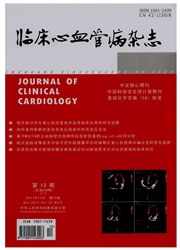

 中文摘要:
中文摘要:
目的:观察门冬氨酸钾镁注射液对家兔缺血再灌注心肌室性心律失常的抑制作用并探讨其抗心律失常作用机制。方法:30只家兔随机分为正常组、心肌缺血组和治疗组,每组10只,制备兔左心室楔形心肌块。正常组持续灌流台氏液,心肌缺血组和治疗组灌流台氏液1h后停灌0.5h,造成心肌缺血,0.5h后复灌台氏液并程序刺激诱发心律失常,治疗组复灌的台氏液中含有浓度为2.42mg/L的门冬氨酸钾镁。采用浮置玻璃微电极法同步记录楔形心肌块内、外膜心肌细胞跨膜动作电位和跨壁心电图,观察正常组、心肌缺血组和治疗组再灌注0.5h的QT间期和内、外膜心肌细胞跨膜动作电位时程以及跨室壁复极离散度(TDR),记录正常组、心肌缺血组和治疗组缺血再灌注时室性心律失常的诱发率。结果:①心肌缺血组较正常组和治疗组TDR明显延长(P〈0.05),治疗组与正常组相比,TDR差异无统计学意义(P〉0.05)。②正常组无一例发生心律失常、心肌缺血组和治疗组室性心律失常的发生率分别为90%(9/10)、10%(1/10),心肌缺血组和治疗组间差异有统计学意义(P〈O.05)。结论:门冬氨酸钾镁可改善再灌注心肌的各项异常的电生理指标,特别是减小TDR,并能够明显降低再灌注心肌室性心律失常的发生率。
 英文摘要:
英文摘要:
Objective:To observe the effect of potassium aspartate and magnesium(PAM) on reperfusion induced ventricular arrhythmias(RIVA) in ischemia-reperfusion(IR) rabbit hearts and studying the antiarrhythmias mechanism of PMA. Method:Thirty rabbits were randomly divided into normal group, ischemia group and treated group. The ventricular wedge preparations were established in all rabbits. In normal group rabbit ventricular wedge preparations were perfused by tyrode's solution, in ischemia group and treated group the tyrode's solution were stopped perfusing for an hour, then in the ischemia group still reperfusd tyrode's solution; but in the treated group reperfused with PAM. The transmural ECG, QT interval, the transmural repolarization dispersion(TDR) and transmembrane action potentials(TAP) from epicardium and endocardium were simultaneously recorded, the RIVA in myocardiums was observed. Result : ①The TDR in ischemia group was significantly prolonged compared with that in normal group and treated group(P〈0.05), but the TDR in treated group didn't have significant difference with that in normal group(P〉0.05). ②The incidences of RIVA in the 3 groups were 0/10,9/10,1/10, the RIVA in ischemia group were significantly suppressed by PAM(P〈0.05). Conclusion: Potassium aspartate and magnesium could not only significantly diminish RIVA but also improve all the electrophysiologic parameters in IR myocardiums especially diminish the TDR.
 同期刊论文项目
同期刊论文项目
 同项目期刊论文
同项目期刊论文
 期刊信息
期刊信息
